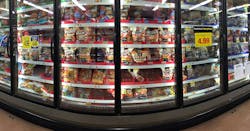Let the Refrigerant Phase-in Begin!
Despite years of speculation and uncertainty, the phasedown of hydrofluorocarbon (HFC) refrigerants has officially arrived in the United States. For food retailers, it’s no longer a question of “if” it will happen, but rather when they will need to act. It also means they will soon be deciding which alternative refrigerants will become the foundations of their future refrigeration strategies.
Unlike the previous generation of commercial refrigeration equipment, there is no one-size-fits-all approach that will solve most retailers’ requirements. Proven eco-friendly refrigerants CO2 (or R-744) and R-290 (aka propane) — as well as emerging A2L options — are among the most likely successors capable of meeting needed global warming potential (GWP) reductions.
Although the entire industry is going through this refrigerant transition together, each retailer will experience their own unique journey. Equipment and architecture decisions should not be taken lightly, as they can impact your operations for the next 10–20 years. It is critically important to align refrigerant choices with a company's long-term operational and sustainability goals.
Regulatory and sustainability drivers
Retailers in California were among the first to make the transition in the U.S., largely in response to HFC phasedown mandates set forth by the California Air Resources Board (CARB). The passing of the American Innovation and Manufacturing (AIM) Act in 2020 laid the groundwork for an HFC phasedown on the federal level, following the guidance of the Kigali Amendment to the Montreal Protocol — an international treaty ratified by more than 150 member countries.
Under the authorization of the AIM Act, the Environmental Protection Agency (EPA) has proposed the next phase of HFC-reduction rulemaking, which sets the stage for the emergence of lower-flammability A2L refrigerants and increased charges of R-290 (subject to use conditions). Finalized in 2023, the EPA’s Technology Transition Rule established sector-based GWP limits and HFC refrigerant restrictions that will drive the use of lower-GWP alternatives, such as A2Ls.
This rule follows the guidance of the Underwriters Laboratories (UL) 60335-2-89, 2nd edition product safety and ASHRAE 15 equipment design standards, which include provisions for the safe use of A2L refrigerants in self-contained, factory-charged units and remote, field-charged refrigeration equipment. UL 60335-2-89, 2nd edition also includes guidance for increased charge limits of R-290 in self-contained refrigeration units and commercial ice machines.
The EPA recently introduced new listings and use conditions for lower-flammability A2L refrigerants in commercial refrigeration under its proposed Significant New Alternatives Policy (SNAP) Rule 26. Combined, the EPA’s Technology Transitions Rule and SNAP Rule 26 proposal are key efforts in establishing a new era of lower-GWP refrigerant technologies.
At the same time, environmental, social and governance (ESG) initiatives are prompting many companies to pledge operational sustainability targets over the coming years and decades. Because refrigerants are a potentially significant contributor to greenhouse gas (GHG) emissions — both directly from leaks into the atmosphere and indirectly from their impact on energy-efficient performance — selecting a next-generation alternative is among the most important sustainability decisions a company can make.
CO2 growth in North America
CO2 refrigeration technologies have been adopted successfully throughout the world for nearly two decades. With a GWP of 1 and zero ozone depletion potential (ODP), CO2 is a sustainable alternative that is poised to play a key role in the U.S. refrigerant transition. Copeland has been developing CO2 system technologies for more than a decade, including compression, controls and components integrated to deliver seamless performance and help simplify CO2 refrigeration applications. CO2 systems and components are designed to manage its inherent high pressures, while R-744’s unique thermophysical characteristics present new opportunities to leverage reclaimed heat for hot water, indoor heating and other repurposing strategies.
Large, centralized CO2 systems
For large retail outlets, CO2 transcritical booster (TCB) systems provide a centralized, all-CO2 strategy for both medium- (MT) and low-temperature (LT) loads. Although early CO2 TCB systems proved to perform well in cooler climates, modern CO2 TCB systems utilize new design approaches to optimize system performance in warm weather conditions as well.
When considering a new CO2 TCB installation, food retailers should factor in utility costs — including electricity and water — and select a design optimization strategy that delivers the lowest total cost of ownership (TCO) in their region. Considering that monthly electricity rates are often driven by peak consumption periods, retailers with installations in high-cost kW/hr regions should do everything possible to minimize high peak usage scenarios.
The expanding potential of R-290
Over the past decade, the natural refrigerant R-290 has emerged as a viable low-GWP (GWP = 3) alternative, especially in smaller, self-contained refrigeration units that don’t require large refrigeration loads. Today, most retailers are familiar with R-290’s widespread use in spot merchandising applications, such as reach-in display cases, beverage coolers, ice machines and ice cream freezers — which don’t require large refrigeration loads.
Although R-290 offers proven sustainability and performance benefits, its A3 “higher flammability” classification must be taken into consideration. To mitigate R-290 safety risks and address safety concerns, the governing bodies that regulate the safe use of refrigerants in the U.S. have long established a 150 grams (5.3 ounces or 0.33 pound) maximum charge limit. The revised UL 60335-2-89, 2nd edition standard approved higher charge limits that potentially could expand the size of R-290 cases, raising the charge limits on commercial self-contained, plug-in displays based on whether they have an open or closed design:
- 500 grams for open appliances (without doors)
- 300 grams for appliances with doors or drawers
It’s important to note that currently in-progress SNAP 26 proposals — as well as model and building code updates — must first be approved before the industry can implement these higher R-290 charges. For now, retailers should be aware that the potential for larger-capacity, self-contained, R-290 units is on the horizon. Copeland is qualifying its R-290 compression lines to enable these larger charges and help OEMs to initiate their new equipment design cycles. Our variable speed Copeland™ scroll compressors deliver twice the capacity and higher speeds, enabling up to 7 HP systems with the anticipated charge limit increases.
Preparing for the emergence of A2Ls
A2L refrigerants have long been recognized as potentially viable alternatives to high-GWP HFCs. A2Ls are composed of multiple chemical components — including those with high hydrofluoroolefin (HFO) content — resulting in a wide range of GWP ratings, including those below 300 and 150 GWP regulatory thresholds. Achieving these low-GWP levels results in a degree of flammability, warranting the A2L “lower flammability” classification, which will require the use of proper safety management and risk mitigation strategies. Leak detection sensors, proper ventilation and safety shut-off valves may be required in some remote systems with larger A2L refrigerant charges.
Not only is Copeland qualifying our compression lines for use with A2Ls with high HFO content, but we are also developing advanced leak detection sensors and controls technologies to help retailers ensure A2L safety, preserve their refrigerant investments, and maximize system performance. Select A2L-qualified compressor models are available for sale today, while samples of all compressors within the A2L qualification process (and their performance data) are available on request. Our new Copeland variable frequency drives, EVM and EVH series, have also been qualified for use in systems with flammable A2L and A3 refrigerants, per relevant component safety standards for commercial refrigeration.
A2L refrigerants fill a much-needed niche within the refrigerant landscape. With charge limits exceeding those proposed for R-290, A2Ls also deliver approximately 20 percent more compressor capacity than R-290. Thus, A2Ls offer a potentially higher-capacity alternative in self-contained applications and a lower-GWP solution for higher-charge distributed and/or remote system applications, such as outdoor condensing units (OCUs) or mini-racks used in smaller-format outlets. These unique characteristics could also provide lower applied costs than CO2 in comparable applications.
A2L adoption in U.S. commercial refrigeration is still in its early stages, as regulatory approvals and safety standards and building codes are currently being finalized and/or adopted. Regardless of which A2L applications may become more commonplace, A2Ls will give retailers another high-performance, low-GWP option for their next-generation refrigeration portfolios.
Make the most informed refrigerant decisions
As retailers plan their refrigerant transitions, many are looking for guidance on how to phase out their high-GWP HFC infrastructures while phasing in lower-GWP, more sustainable replacement refrigerant strategies. Copeland has the application expertise, product portfolios and value-added services to help retailers make successful and cost-effective refrigerant transitions.
We recently completed two extensive research projects designed to help retailers evaluate which refrigerants and infrastructures align closest with their operational and sustainability goals. Our Total Cost of Ownership (TCO) study can help you to compare various low-GWP refrigerant architectures to determine which strategies deliver the most optimal short- and long-term cost savings and GWP reductions for your operation.
For those retailers exploring CO2 TCB systems for new store installations, our CO2 Climate Study can provide guidance on selecting a design optimization strategy that can help you to maximize energy efficiencies and deliver the lowest TCO per your unique climate zone and utility considerations.
Regardless of where your company is on its refrigerant transition, Copeland is ready to help you evaluate emerging refrigerant solutions and take the next steps on your journey. To learn more about Copeland’s low-GWP, alternative refrigerant-based solutions and application expertise, please visit the emerging refrigerants section of our website.
Jeff Lichty is Director, Product Management at Copeland.

